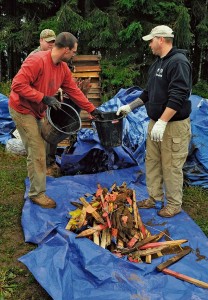Although the sun is up, you could hardly tell through the dense fog creating an eerie feeling at the dig site. Everyone had their warmest jackets on as they prepared to load everything up after a long year and a half of digging.
Over the hill, there was a large crater created years ago by an aircraft crash. All the greenery around the crater was gone. The only thing left was dirt and tree stumps.
Working together, volunteers packed up all equipment used for the Joint POW/MIA Accounting Command’s mission Sept. 13.

Volunteers with the Joint POW/MIA Accounting Command clean the area around an excavation site Sept. 13 in Belgium after completing a year and a half of digging.
According to their website, JPAC conducts global search, recovery and laboratory operations to identify unaccounted-for Americans from past conflicts.
“We try to give the fullest possible accounting of missing service members from World War II to present day,” said Sgt. 1st Class Michael Ospina, JPAC mission team leader. “It was a commitment that we have made, ‘never leave a fallen comrade behind,’ and that’s why we’re here.”
The main command is located on Oahu, Hawaii, was activated Oct. 1, 2003, and employs more than 400 joint military and civilian personnel to search for more than 83,000 Americans still missing.
“Since our mission window here is done, our senior anthropologist will go back to Hawaii, look through what we found and decide if there needs to be further excavation done at this site,” Ospina said.
Trying to find things like bones, aircraft parts and life support items has more to it than just digging in the
dirt.
“We set up the site in grid patterns to make it look like a giant map. Then we dug in each section and sifted through the dirt,” Ospina said. “If someone found something, we would then dig all around that section to hopefully find more.”
The site was so large the JPAC crew had to split it in half. There was a total of 1,200 square meters of dirt they sifted through looking for items.
“One of the major challenges we had were the trees,” Ospina said. “There were trees planted after the crash, and in order to be thorough, we had to have the trees chopped down. We had to dig under the roots. That took a lot of time, but it’s something we had to do.”
It’s also something that couldn’t have been accomplished without the help of volunteers in the surrounding areas, Ospina added.
“My primary reason for volunteering was because this is an important mission, and being a spouse, it made me think, ‘What if my husband was gone?’ It is nice to know that there will be someone looking for him,” said Shannon Kicza, wife of Maj. Daniel Kicza. “I am also an archaeologist and saw this as an opportunity to put my skills to good use.”
JPAC’s Central Identi-fication Laboratory is the largest and most diverse forensic skeletal laboratory in the world and identifies about six Americans a month on average.
JPAC has recovered and identified more than 1,700 Americans, allowing those families to gain the much-needed closure.
“What is my favorite part?” Kicza said. “It is those moments when you find material, and you just know that you are holding a major piece of history. That’s my favorite part.”
For more information on JPAC, visit their website at www.jpac.pacom.mil.







